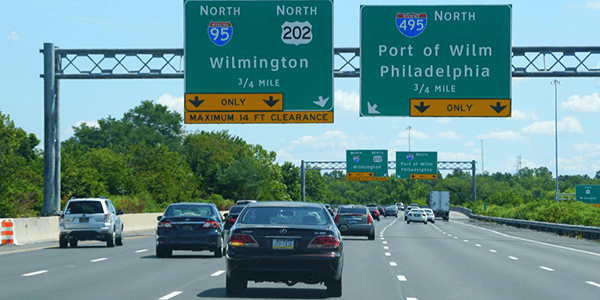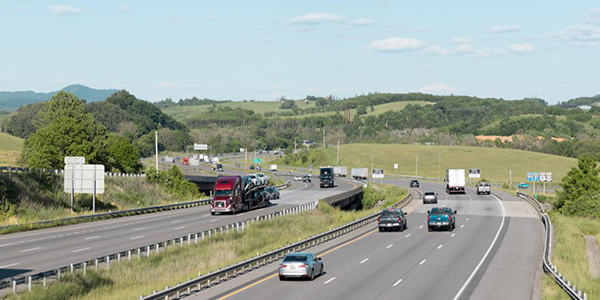In the United States, 10.5% of drivers nationwide have a speeding ticket on their record.
These tickets can be costly — not simply in terms of the cost of the ticket itself, but also for insurance rates.
Forbes Advisor found that a speeding ticket can jack up a driver’s insurance by an average of 24%, or close to $400 per year.
Ever since 1896, when Englishman Walter Arnold got the first speeding ticket for driving 8 mph in a 2 mph zone, drivers have had problems with lead feet. Speed limits exist to keep traffic moving at a safe speed. That speed can vary depending on the type of road you’re driving on and the density of the area.
Traditionally, states set their own speed limits, though for a time in the 1970s and 1980s, a national law invoked by the Nixon Administration set speed limits at 55 mph throughout the country. Fittingly, the enforcement of this law inspired Sammy Hagar to write “I Can’t Drive 55” after the singer was pulled over for speeding on I-87 in New York. This statute was later amended to allow speeds up to 65 mph before being completely repealed in 1995, handing authority to set speed limits back to the states.
Speeding can be a major factor in car crashes; the faster a car is traveling, the more likely a crash will turn deadly. In 2020, the National Safety Council found that speeding contributed to 29% of all traffic fatalities, killing 11,258 people — an average of 30 lives lost to excess speed every day.
RateGenius compiled a list of the states with the highest percentage of drivers with speeding tickets based on 2021 data from car insurance platform Insurify. The dataset is built from a database of over 2.9 million car insurance applications, which include disclosures on the driver’s state of residence and driving history. The maximum speed limit data also included in this list comes from the Insurance Institute for Highway Safety and is specific to urban interstates. Outside of urban areas, speed limits may be higher.
These top speeders come from all over the U.S. Three of the top 10 states are along the East Coast, four are in the Midwest, and the remaining three are in the West — proving that the need for speed is not a regional impulse, but a decidedly American one. So, with one foot on the break and one on the gas, read on to see where America’s biggest speeders come from.

Khairil Azhar Junos // Shutterstock
#10. Delaware
- Drivers who have prior speeding tickets: 13.2%
- Maximum speed limit on urban interstates: 55 mph
Delaware is a tiny state where a lot of drivers get caught speeding. In fact, its driving population speeds 21% more than the national average. In January 2022, the state began using cameras along an I-95 construction zone to reduce speeding and crashes and improve safety for construction workers. This was spurred by a 49% increase in car crashes in this area from 2019 to 2021, when there were 423 accidents.

Inbound Horizons // Shutterstock
#9. Idaho
- Drivers who have prior speeding tickets: 13.3%
- Maximum speed limit on urban interstates: 80 mph
Idaho may have a high speed limit, but it also has a large percentage of drivers who have speeding tickets on their driving record. Those tickets don’t come cheap either. If you get a speeding ticket for going 1 to 15 miles over the limit, the fine is $90. Driving 16-plus miles over the limit is a total of $155.

haveseen // Shutterstock
#8. Wyoming
- Drivers who have prior speeding tickets: 13.7%
- Maximum speed limit on urban interstates: 80 mph
Wyoming has wide open spaces and a low population — less than 600,000 people live in the entire state — so it has some of the highest speed limits in the country. That said, many sections of Wyoming’s highways have variable speed limits due to the state’s fast-changing weather conditions, particularly in winter. The Wyoming Department of Transportation implemented variable speed limits to lower the rate of car crashes caused by people driving too fast for the conditions.

Sandra Foyt // Shutterstock
#7. Nebraska
- Drivers who have prior speeding tickets: 13.8%
- Maximum speed limit on urban interstates: 70 mph
Get caught speeding in Nebraska, and the fines start out small — just $10 for going 1 to 5 miles over the posted speed limit. Drivers who travel between 20 to 34 miles over the speed limit are fined $200, and if you’re really gunning it (more than 35 mph over the limit), you’re looking at a $300 hit. Nebraska State Patrol handed out 880 tickets to drivers going faster than 100 mph in 2021, representing a 37% increase compared to the five-year average prior to the pandemic.

Vicki L. Miller // Shutterstock
#6. Colorado
- Drivers who have prior speeding tickets: 14.0%
- Maximum speed limit on urban interstates: 65 mph
When businesses shut down during the pandemic, Coloradans took to the roads, particularly young adults. Between 2019 and 2021, the Colorado State Patrol doled out more speeding tickets to drivers 16 to 21-years-old (9,240 in 2021 alone) than for any other traffic violation.
In Colorado, you could spend time behind bars if you’re caught speeding. Going 25 mph or more over the speed limit is considered a misdemeanor traffic offense that can incur a $150 to $300 fine and/or a 10- to 90-day jail sentence.



Canva
#5. Wisconsin
- Drivers who have prior speeding tickets: 14.8%
- Maximum speed limit on urban interstates: 70 mph
Wisconsin state law requires drivers to be “reasonable and prudent,” meaning that they should take road conditions and hazards into account when driving, and drive accordingly. That said, the state also has fixed speed limits for various circumstances, such as driving on a highway or near a school. Yet, 14.8% of Wisconsinites don’t exercise prudent judgment, as speeding is the most common traffic violation in the state.
A speeding ticket can be an expensive problem in Wisconsin. Tickets consist of a state-mandated base deposit, plus other fees and costs. This means that your speeding ticket could run anywhere from $200 to over $800, depending on the severity of the violation.

Kristi Blokhin // Shutterstock
#4. South Carolina
- Drivers who have prior speeding tickets: 15.5%
- Maximum speed limit on urban interstates: 70 mph
South Carolina’s famous beaches may promote a slow way of life, but its drivers are anything but slow. In 2019, “driving too fast for conditions” took the top spot in primary contributing factors to fatal collisions, injury collisions, and total collisions in South Carolina.
Paying a ticket is not the only hassle drivers have when they’re caught for speeding in South Carolina. The state is one of many with a points system, by which a certain number of points is added to your driving record for various levels of speeding. Rack up enough points, and your driver’s license could be suspended.

FTiare // Shutterstock
#3. Iowa
- Drivers who have prior speeding tickets: 15.6%
- Maximum speed limit on urban interstates: 55 mph
Rural life doesn’t mean slow living to Iowa drivers. The state’s placement at third on this list is actually an improvement from its 2020 second-place ranking, when 17.6% of drivers had speeding tickets. That said, Iowans do have a track record for revving their motors — in 2020, speeding violations in excess of 25 mph or more increased 74%. Iowa State Patrol officers also gave out 1,497 speeding tickets for speeds over 100 mph — a 108% increase from the four-year average.

LisaCarter // Shutterstock
#2. Virginia
- Drivers who have prior speeding tickets: 15.8%
- Maximum speed limit on urban interstates: 70 mph
Virginia may be for lovers, but it’s also a place where they drive fast. Virginia imposes both fines and points for speeding violations, which can haunt you for years. A speeding ticket for driving just 1 mile over the limit will earn you three points, and those points will stay on your record for five years. Driving over 85 mph (or 20 mph over the speed limit on any road) is considered reckless driving, which is upgraded to a felony or misdemeanor charge, with six points that stay on your record for 11 years.

Brian Kapp // Shutterstock
#1. Ohio
- Drivers who have prior speeding tickets: 16.1%
- Maximum speed limit on urban interstates: 65 mph
Ohio tops the list with the percentage of drivers who have prior speeding tickets, and the pandemic may have played a role in that. The Ohio State Patrol saw a significant increase in speeding during the first year of the pandemic, with drivers taking advantage of empty roads, and this hasn’t wavered since. In 2020, despite overall ticketing going down by just over 100,000 from 2019, state troopers still wrote 80% more tickets to drivers doing at least 100 mph than in 2019.
;)













